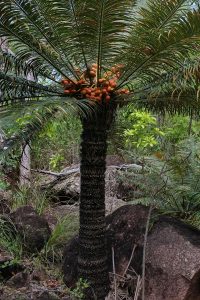
Form and Size: Trunk 1-3m tall, stout, unbranched.
Distribution: From Cape York south to Gladstone, Qld.
Leaves: Pinnate, 0.5-1.5m long, leathery; 40-50 pairs of leaflets, narrow, straight or sickle-shaped, stiff, 10-13cm x 1-1.5cm. Flowers: Male cones slender, woolly, 30-45cm long; female spikes lance-shaped, sharp tip, toothed margins, about 40cm long; 4-6 ovules per spike.
Fruit: Orange, oval, 2-4cm long.
Cultivation/Notes: Propagation is from seed, which is best while fresh. Some species germinate readily while others may take 12-18 months. Seed should be sown in a sandy mixture and only half covered. Potting up may be done when the seeds have been seen to develop roots.
All parts of this plant are considered poisonous.
However, Indigenous Australians developed a long and careful method to prepare Cycas media seeds. Their procedure, as described by botanist Anthelme Thozet, was recounted in a 1899 book “The Useful Native Plants of Australia” by J.H. Maiden:
“The nuts are deprived of their outer succulent cover (sarcocarp) and are then broken; and the kernels, having been roughly pounded, are dried three or four hours in the sun, then brought in a dilly-bag to a stream or pond, where they remain in the running water four or five days, and in stagnant water three or four days. By a touch of the fingers the proper degree of softness produced by maceration is ascertained.”
The softened kernels were placed between two stones, reduced to a fine paste, and then baked under the ashes “in the same way that our bush people bake their damper.” (Thozet quoted by Maiden, 1899.)
Today we would add the qualification: “Don’t try this at home!”